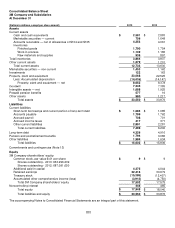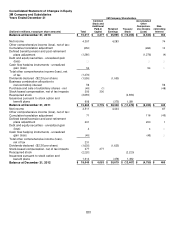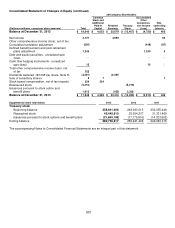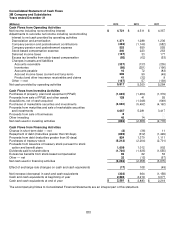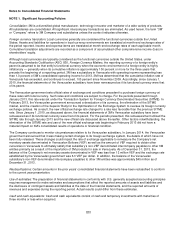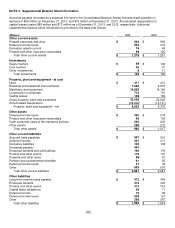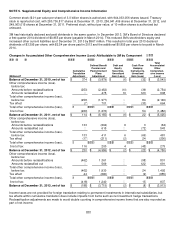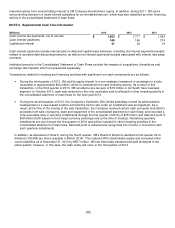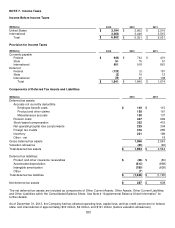3M 2013 Annual Report Download - page 64
Download and view the complete annual report
Please find page 64 of the 2013 3M annual report below. You can navigate through the pages in the report by either clicking on the pages listed below, or by using the keyword search tool below to find specific information within the annual report.58
In July 2012, the FASB issued ASU No. 2012-02, Testing Indefinite-Lived Intangible Assets for Impairment. Under this
standard, entities testing long-lived intangible assets for impairment now have an option of performing a qualitative
assessment to determine whether further impairment testing is necessary. If an entity determines, on the basis of
qualitative factors, that the fair value of the indefinite-lived intangible asset is more-likely-than-not less than the carrying
amount, the existing quantitative impairment test is required. Otherwise, no further impairment testing is required. For 3M,
this ASU was effective beginning January 1, 2013. The adoption of this standard did not have a material impact on 3M’s
consolidated results of operations or financial condition.
In February 2013, the FASB issued ASU No. 2013-02, Reporting of Amounts Reclassified Out of Accumulated Other
Comprehensive Income. Under this standard, entities are required to disclose additional information with respect to
changes in accumulated other comprehensive income (AOCI) balances by component and significant items reclassified
out of AOCI. Expanded disclosures for presentation of changes in AOCI involve disaggregating the total change of each
component of other comprehensive income (for example, unrealized gains or losses on available for sale debt and equity
securities) as well as presenting separately for each such component the portion of change in AOCI related to (1)
amounts reclassified into income and (2) current-period other comprehensive income. Additionally, for amounts
reclassified into income, disclosure in one location is required, based upon each specific AOCI component, of the
amounts impacting individual income statement line items. Disclosure of the income statement line item impacts is
required only for components of AOCI reclassified into income in their entirety. Therefore, disclosure of the income
statement line items affected by AOCI components such as net periodic benefit costs is not included. The disclosures
required with respect to income statement line item impacts are to be made in either the notes to the consolidated
financial statements or parenthetically on the face of the financial statements. For 3M, this ASU was effective beginning
January 1, 2013. The additional disclosures required by this ASU are included in Note 5. Because this standard only
impacts presentation and disclosure requirements, its adoption did not have a material impact on 3M’s consolidated
results of operations or financial condition.
In March 2013, the FASB issued ASU No. 2013-05, Parent’s Accounting for the Cumulative Translation Adjustment upon
Derecognition of Certain Subsidiaries or Groups of Assets within a Foreign Entity or of an Investment in a Foreign Entity.
This standard provides additional guidance with respect to the reclassification into income of the cumulative translation
adjustment (CTA) recorded in accumulated other comprehensive income associated with a foreign entity of a parent
company. The ASU differentiates between transactions occurring within a foreign entity and transactions/events affecting
an investment in a foreign entity. For transactions within a foreign entity, the full CTA associated with the foreign entity
would be reclassified into income only when the sale of a subsidiary or group of net assets within the foreign entity
represents the substantially complete liquidation of that foreign entity. For transactions/events affecting an investment in a
foreign entity (for example, control or ownership of shares in a foreign entity), the full CTA associated with the foreign
entity would be reclassified into income only if the parent no longer has a controlling interest in that foreign entity as a
result of the transaction/event. In addition, acquisitions of a foreign entity completed in stages will trigger release of the
CTA associated with an equity method investment in that entity at the point a controlling interest in the foreign entity is
obtained. For 3M, this ASU is effective prospectively beginning January 1, 2014, with early adoption permitted. This ASU
would impact 3M’s consolidated results of operations and financial condition only in the instance of an event/transaction
as described above.


